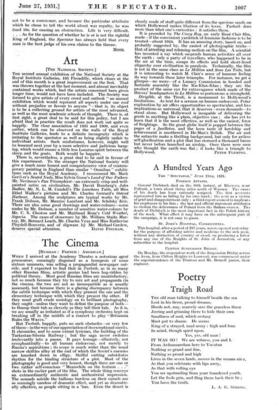The Cinema
[RUSSIAN : FRENCH : AMERICAN.]
WHEN I arrived at the Academy Theatre a notorious agent provocateur, cunningly disguised as a bourgeois of some sixteen summers, was selling a propagandist newspaper out- side, and I expected to find that in Turksib, as in so many other Russian films, artistic genius had been hag-ridden by political theory. Most good Russian films are unsatisfactory, not so much because they try to mix art and propaganda (in the cinema, the two are not as incompatible as is usually assumed), but because there is a glaring discrepancy between the subtle technique with which they present the one and the elementary technique with which they present the other. If they must graft crude sociology on to brilliant photography, they ought—unless they want to defeat the purpose of both— to thump their tub as cleverly as they tell their tale. As it is, we are usually as irritated as if a symphony orchestra kept on breaking off in the middle of a concert to play "Britannia Rules the Waves."
But Turlcsib, happily, puts no such obstacles—or very few of them—in the way of our appreciation of its exceptional merits. It chronicles, and to some extent lyricizes, the building of the Turkestan-Siberia Railway ; but the saga never switches irrelevantly into a paean. It pays homage—allusively, not sycophantically—to all human endeavour, not merely to Russia's aspirations ; its scope is much wider than the usual narrow skittles alley at the end of which the Soviet's enemies are knocked down in effigy. Skilful cutting substitutes rhythm - for the binding structure of a plot. Most of the photography is good and very honest, though there are one or two rather self-conscious " Meanwhile on the horizon . . ." shots in the earlier part of the film. The whole thing conveys an extraordinarily authentic and untheatrical impression. The nomads astride the bulbous burdens on their camels are as seemingly careless of dramatic effect, and yet as dramatic- ally effective, as people sitting in a 'bu.s. Even the desert is clearly made of stuff quite different from the specious sands on which Hollywood makes libation of its loves. Turksib does more than whet one's curiosities ; it satisfies them.
It is preceded by The Crazy Ray, an early Rene Clair film, made—if the convenient yardstick of feminine fashions is to be trusted—about 1924. It has an amusing story, based on, and probably suggested by, the easiest of photographic tricks— that of arresting and releasing motion on the film. A scientist has invented a ray which suspends human activities all over the earth ; only a party of travellers, who happened to be in the air at the time, escape its effects and hold short-lived oligarchy over civilization in paralysis. Technically, the film is not in the same class as Le Million and Sous Les Toils, but it is interesting to watch M. Clair's sense of humour feeling its way towards these later triumphs. For instance, we get a glimpse—no more—of a Lunacy Commission in hooded and fantastic assembly like the Ku-Klux-Klan ; they are the product of the same eye for extravagance which made of the thieves' headquarters in Le Million so portentous a stronghold. Dirigible, at the Tivoli, is a monument to Hollywood's limitations. As text for a sermon on human endeavour, Polar exploration by air offers opportunities so spectacular, and has implications so universal, that it deserves—even demands—to stand alone. But Hollywood is incapable of delivering the goods in anything like a plain, objective van ; she has yet to learn that it is the most effective, as well as the easiest, form of freightage. So the great globe itself is popped between the pages of a fueilleton, and the keen taste of hardship and achievement is smothered in He-Man's Relish. The air and the antarctic make a thrilling background, but only for artless self-glorification and a plot that has stormed a thousand barns but never before launched an airship. Once there were men who thought the earth Was flat ; it looks like a triangle to






































 Previous page
Previous page